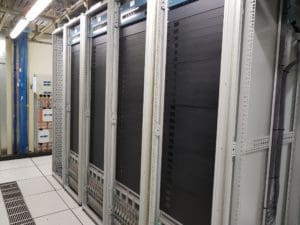Data centre efficiency is more than just a buzzword; it’s a critical factor in maximising your operational performance while minimising energy costs. At EziBlank, we understand the complexities of managing air-flow and energy consumption in data centres, and our innovative solutions are specifically designed to tackle these challenges. Our expertly engineered blanking panels not only streamline your infrastructure but also help you achieve significant savings on electricity bills. Embrace a sustainable future and enhance your data centre's capabilities with EziBlank, where efficiency meets innovation.
How Server Blanking Panels Improve Data Center Efficiency
Optimising data centre efficiency is a crucial task, and server blanking panels are an often-overlooked solution that plays a significant role. These panels help in managing airflow within server racks, preventing hot air recirculation and ensuring that cooling systems operate more effectively. By maintaining the proper thermal environment, blanking panels contribute to reduced energy consumption and lower operational costs, making them an essential component for data centres aiming for peak performance and sustainability.
Read More
Elevate Data Center Performance with Blanking Panels
Enhancing the performance of data centres often hinges on small yet impactful innovations, such as the strategic use of blanking panels. These panels are designed to cover unused spaces in server racks, preventing hot air from recirculating and ensuring that cooling systems work at peak efficiency. By improving airflow management, blanking panels help maintain optimal operating conditions for servers, reducing the risk of overheating and boosting overall system performance. For data centres striving to maximise efficiency and reliability, blanking panels offer a straightforward and effective solution.
Read More
What are blanking panels and how do they work?
Blanking panels are a critical yet often underappreciated component in the design of efficient data centres. These panels are used to cover empty spaces within server racks, preventing the unwanted mixing of hot and cold air. By directing the airflow more effectively, blanking panels ensure that cooling systems operate more efficiently, reducing the energy required to maintain optimal temperatures. This not only enhances the performance and longevity of the equipment but also contributes to significant energy savings, making blanking panels a simple but powerful tool in data centre management.
Read More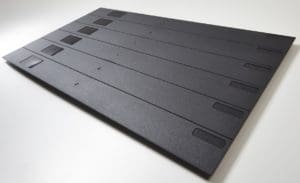
The Power of Eziblank Blanking Panels for Data Center Retrofits
When it comes to retrofitting data centres, EziBlank® blanking panels offer a straightforward yet highly effective solution to enhance cooling efficiency and reduce energy consumption. These panels are specifically designed to seal unused rack spaces, preventing hot air from recirculating into the cold aisle and ensuring that cooling efforts are focused where they are needed most. By optimising airflow management, EziBlank® panels not only improve the overall performance of the data centre but also extend the life of critical equipment. For data centres looking to upgrade without extensive overhauls, EziBlank® blanking panels provide a cost-effective and impactful option.
Read More
Innovative Solutions for Data Center Cooling
Effective cooling solutions are vital for the smooth operation of data centres, where temperature control is critical to maintaining equipment reliability and performance. Various strategies are employed to manage heat, from advanced liquid cooling systems that directly cool high-density servers to traditional air cooling enhanced by precision airflow management. The use of blanking panels is a simple yet powerful method to improve air circulation, preventing hot spots and reducing the workload on cooling systems. By implementing a combination of these cooling technologies, data centres can optimise their energy efficiency, lower operational costs, and ensure that their infrastructure remains robust and reliable.
Read More
Best Practices for Data Center Scalability
Scalability is a cornerstone of modern data centre management, ensuring that facilities can grow and adapt to meet increasing demands without compromising performance. Best practices for achieving scalability include modular design, which allows for the incremental addition of capacity, and the implementation of efficient cooling solutions that can be scaled alongside the infrastructure. The use of blanking panels to manage airflow and reduce energy consumption is another key strategy, as it supports both current and future expansion needs. By focusing on these scalable solutions, data centres can remain agile and responsive to the ever-evolving technological landscape.
Read More
What are data centre floor tiles
Data centre floor tiles are an essential component of the infrastructure that helps manage airflow and support the weight of heavy equipment. Typically used in raised floor systems, these tiles are designed to allow for the efficient distribution of cool air from below the floor to the servers above. Perforated or vented tiles are particularly common, as they enable controlled airflow to specific areas, ensuring that cooling is directed where it's most needed. In addition to their functional role, these tiles must also be durable enough to withstand the constant load and movement of heavy server racks, making them a critical element in maintaining the overall efficiency and safety of a data centre.
Read More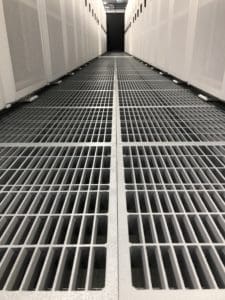
The Importance of Energy Efficiency in Data Centres
Energy efficiency is a crucial factor in the operation of data centres, as these facilities consume vast amounts of power to keep servers running and maintain optimal cooling conditions. Improving energy efficiency not only reduces operational costs but also lessens the environmental impact of data centres, aligning with global sustainability goals. Strategies such as implementing advanced cooling systems, utilising renewable energy sources, and optimising airflow management with tools like blanking panels are key to achieving higher energy efficiency. By focusing on these areas, data centres can enhance performance while contributing to a more sustainable future.
Read More
Choosing the Right Blanking Panels for Your Data Centre
Selecting the appropriate blanking panels for your data centre is a crucial step in optimising airflow and improving overall energy efficiency. Blanking panels, which fill unused spaces in server racks, are available in various sizes and materials to suit different configurations and needs. Choosing the right panels involves considering factors such as rack dimensions, the type of cooling system in place, and the specific airflow requirements of your equipment. Properly installed blanking panels help prevent hot air recirculation, ensuring that cooling systems operate more effectively, thereby reducing energy consumption and enhancing the performance and longevity of your data centre’s infrastructure.
Read More
How Are Server Racks Measured?
Server racks are measured primarily in terms of their height, which is expressed in units known as "rack units" or "U." Each rack unit corresponds to 1.75 inches (44.45 mm) of vertical space, and standard server racks typically range from 42U to 48U in height, though smaller and larger sizes are available. The width and depth of server racks are also important, with most racks being 19 inches wide to accommodate standard equipment sizes, while depth can vary to support different types of hardware. Understanding these measurements is crucial for ensuring that all servers, networking devices, and other components fit properly within the rack, allowing for efficient use of space and optimal cooling.
Read More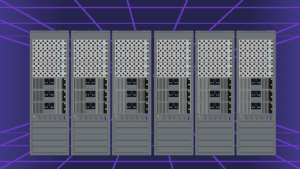
How much does it cost to build a data center?
The cost of building a data centre can vary widely depending on factors such as location, size, design specifications, and the level of technology incorporated. On average, constructing a small to mid-sized data centre can range from several million to tens of millions of dollars. Larger, hyperscale data centres, which are designed to support massive computing needs, can cost hundreds of millions to over a billion dollars. These costs include land acquisition, construction, electrical and cooling infrastructure, security systems, and the installation of servers and networking equipment. Additionally, ongoing operational costs such as energy, maintenance, and staffing must be factored into the total investment, making data centres a significant financial commitment for any organisation.
Read More
Everything you need to know about data center power
Power is the lifeblood of any data centre, underpinning the operation of servers, cooling systems, and networking equipment. Ensuring a reliable and continuous power supply is critical, as even a brief outage can lead to significant disruptions. Data centres typically rely on a combination of grid electricity, uninterruptible power supplies (UPS), and backup generators to maintain operations during power failures. Power distribution within the facility must be carefully managed to ensure that all equipment receives the necessary voltage and current, while also allowing for redundancy to prevent failures. Additionally, the efficiency of power usage is a key concern, with modern data centres adopting technologies like power usage effectiveness (PUE) metrics to optimise energy consumption and reduce costs. Understanding these aspects of data centre power is essential for maintaining high performance and reliability in a facility.
Read More
Is a green data center good for business?
A green data centre is not only beneficial for the environment but also offers significant advantages for businesses. By focusing on energy efficiency, renewable energy sources, and sustainable practices, green data centres help reduce operational costs through lower energy consumption and improved efficiency. This reduction in costs can translate into higher profitability over time. Additionally, operating a green data centre enhances a company’s reputation by demonstrating a commitment to sustainability, which can attract environmentally conscious customers and partners. Moreover, as regulations around carbon emissions tighten, having a green data centre can ensure compliance and reduce the risk of penalties. Overall, investing in a green data centre is a smart business decision that aligns economic performance with environmental responsibility.
Read More
Data Center Checklist
A comprehensive data centre checklist is an invaluable tool for ensuring that all critical aspects of data centre management are addressed. This checklist typically covers a wide range of areas, including physical infrastructure, power management, cooling systems, security measures, and network connectivity. Key items might include verifying the integrity of power supply and backup systems, ensuring efficient cooling with proper airflow management and blanking panels, and confirming that all security protocols, such as access controls and surveillance, are in place. Additionally, regular maintenance schedules, disaster recovery plans, and compliance with industry standards should be reviewed and updated. Using a detailed checklist helps data centre managers maintain operational efficiency, minimise downtime, and ensure that the facility is prepared to meet current and future demands.
Read More
How to create the perfect data center airflow management plan
Creating the perfect data centre airflow management plan is essential for optimising cooling efficiency, reducing energy consumption, and ensuring the longevity of your equipment. The process begins with a thorough assessment of the current airflow dynamics, identifying any hot spots or areas where air circulation is suboptimal. Key components of an effective plan include the strategic placement of blanking panels to prevent hot air recirculation, proper cable management to avoid airflow blockages, and the use of perforated floor tiles to direct cool air precisely where it’s needed. Additionally, implementing cold or hot aisle containment can further enhance airflow efficiency by separating hot and cold air streams. Regular monitoring and adjustments are crucial to maintaining optimal conditions as the data centre evolves. By focusing on these elements, you can create an airflow management plan that maximises performance and minimises costs.
Read More
How to Maintain Your Data Center
Maintaining a data centre is crucial for ensuring its reliability, efficiency, and longevity. Regular maintenance involves several key practices, starting with routine inspections of power and cooling systems to prevent potential failures and optimise performance. Ensuring that all equipment, including servers and networking devices, is updated with the latest firmware and software patches is essential for security and functionality. Effective cable management and the use of blanking panels help maintain proper airflow, which is critical for cooling efficiency. Additionally, conducting regular backups and testing disaster recovery plans ensure that data is protected against unexpected events. By adhering to these maintenance practices, a data centre can operate smoothly, reduce downtime, and extend the lifespan of its infrastructure.
Read More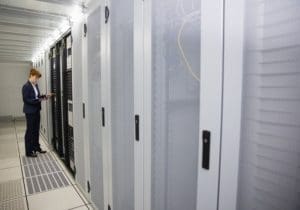
Airflow Management Products
Airflow management products are essential tools for optimising cooling efficiency and maintaining the performance of data centres. These products include blanking panels, which are used to cover unused spaces in server racks, preventing hot air from recirculating and ensuring that cool air is directed precisely where it’s needed. Perforated floor tiles are another key product, allowing controlled cool air delivery from beneath the raised floor to the servers. Additionally, air curtains and containment systems, such as hot and cold aisle containment solutions, help separate hot and cold air streams, further enhancing cooling efficiency. By implementing these airflow management products, data centres can reduce energy consumption, improve equipment longevity, and maintain optimal operating conditions.
Read More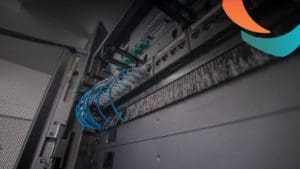
Hot Aisle Containment Solutions & Products
Hot aisle containment solutions typically include barriers, doors, and ceiling panels that effectively seal off the hot aisle, creating a controlled environment where the separation of hot and cold air is meticulously maintained. This separation ensures that hot exhaust air is directed away from the servers and into return air ducts, preventing it from mixing with the cool intake air and thereby enhancing the efficiency of the cooling system. Implementing these solutions not only significantly reduces energy consumption and lowers cooling costs but also enhances the overall performance, reliability, and lifespan of the data centre’s infrastructure, making it a vital strategy for modern data centres aiming to optimise their operations.
Read More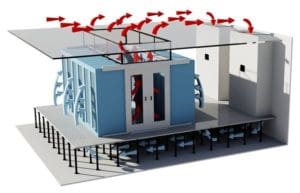
Green Data Center Case Study
A green data centre case study highlights how implementing sustainable practices can lead to significant environmental and financial benefits. In one example, a data centre achieved substantial energy savings by integrating renewable energy sources such as solar and wind power into its operations. Additionally, the facility utilised advanced cooling technologies, including free cooling and liquid cooling systems, which drastically reduced the reliance on traditional, energy-intensive air conditioning. The implementation of hot and cold aisle containment systems further optimised airflow, minimising energy waste. Through these initiatives, the data centre not only reduced its carbon footprint but also realised considerable cost savings, demonstrating that sustainability and efficiency can go hand in hand. This case study serves as a model for other facilities aiming to transition towards greener, more energy-efficient operations.
Read More
What is Cold Aisle Containment
Cold aisle containment is a data centre cooling strategy designed to improve energy efficiency and optimise temperature control. In this setup, the cold aisle, where the fronts of the server racks are located, is enclosed to prevent the mixing of cold air with the hot exhaust air from the servers. This containment system ensures that the cool air from the air conditioning units is directed exclusively towards the servers' intake, maximising cooling efficiency. By containing the cold aisle, data centres can maintain lower temperatures with less energy, reducing the workload on cooling systems and lowering overall energy consumption. This approach not only improves the performance and reliability of the equipment but also contributes to significant cost savings and a more sustainable data centre operation. Cold aisle containment is particularly effective in high-density data centres where cooling demands are substantial.
Read MoreThe Complete Guide to Data Center Cooling
Effective data centre cooling is essential for maintaining the reliability and efficiency of IT infrastructure. Key strategies include optimising airflow through techniques like hot and cold aisle containment, which separates hot and cold air to enhance cooling efficiency. Blanking panels are used to fill unused rack spaces, preventing hot air recirculation and ensuring cool air reaches where it's needed most. Advanced technologies like liquid cooling, which circulates coolant directly to hot components, and free cooling, which utilises natural cold air or water, further reduce energy consumption. Real-time monitoring of temperature and humidity allows for precise control, ensuring optimal conditions while minimising energy use. Together, these approaches protect equipment, lower operational costs, and contribute to a more sustainable data centre.
Read MoreWhat is Hot Aisle Containment
Hot aisle containment is a cooling strategy used in data centres to improve energy efficiency by isolating the hot air generated by servers. In this setup, the hot aisle, where the backs of the servers expel warm air, is enclosed, preventing the hot air from mixing with the cool air in the rest of the data centre. This containment ensures that the hot air is directed straight to the cooling units, where it is removed or recycled, thereby reducing the workload on the cooling system. By maintaining a clear separation between hot and cold airflows, hot aisle containment helps to lower energy consumption, enhance cooling efficiency, and maintain optimal operating conditions for the servers, making it a crucial strategy for modern data centre management.
Read More
The Ultimate Guide to Data Centers
Data centres are the backbone of the digital world, housing the servers and networking equipment that power everything from websites to cloud computing services. A well-designed data centre must balance performance, efficiency, and security, with key considerations including location, infrastructure, power supply, cooling systems, and security measures. Effective airflow management, such as the use of blanking panels and hot/cold aisle containment, is essential for maintaining optimal temperatures and reducing energy consumption. Additionally, data centres must incorporate robust backup systems, such as uninterruptible power supplies (UPS) and generators, to ensure continuous operation in the event of power failures. As businesses increasingly rely on digital infrastructure, the role of data centres continues to expand, making it crucial to optimise their design and operations for reliability, efficiency, and scalability.
Read More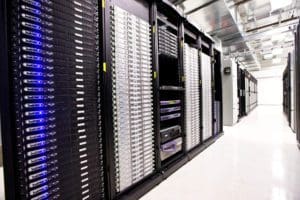
SRA Solutions recommend EziBlank for data centre air flow management
SRA Solutions recommends EziBlank® for data centre airflow management due to its effectiveness in optimising cooling efficiency and enhancing overall data centre performance. EziBlank® blanking panels are designed to fill unused rack spaces, preventing the recirculation of hot air and ensuring that cool air is directed precisely where it is needed. This targeted airflow management helps maintain optimal operating temperatures, reduces the strain on cooling systems, and lowers energy consumption. By incorporating EziBlank® panels, data centres can achieve significant improvements in cooling efficiency, operational reliability, and energy cost savings, making them a highly recommended solution by industry experts like SRA Solutions.
Read More